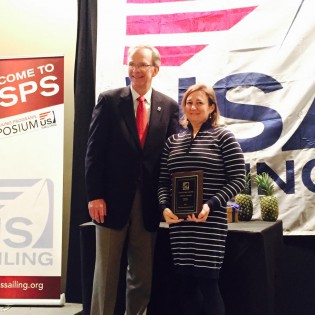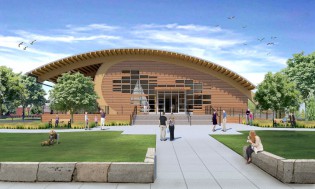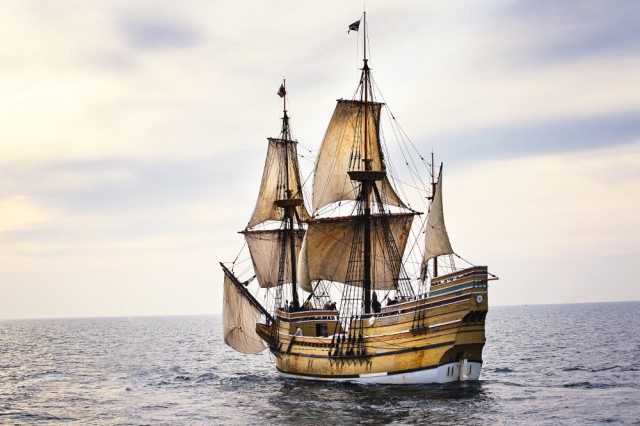Restoration of Iconic Ship Essential for Historic 2020 Commemoration
Plymouth, MA (December 4, 2014)—Plimoth Plantation and Mystic Seaport, both acclaimed New England history museums, are pleased to announce a collaborative project to restore and repair Mayflower II, a full-scale reproduction ship owned by Plimoth Plantation. Work on the historic ship will take place at the Henry B. duPont Preservation Shipyard at Mystic Seaport, adhering to The Secretary of the Interior’s Standards for Vessel Preservation Projects. A cohesive restoration plan will be established in conjunction with Plimoth Plantation’s Maritime Artisans Program, led by the museum’s newly-hired Associate Director for Maritime Preservation and Operations, Whit Perry. Mayflower II is scheduled to depart the Plymouth waterfront for Mystic Seaport sometime over the next several days depending on weather conditions.
Work will begin in December on a multi-year phased restoration plan, honoring the ship’s original construction and using traditional methods with the goal of restoring the ship to her original state when she first arrived to Plymouth in 1957. Inspections in 2013 revealed that Mayflower II is in need of a major refit, which is normal for a nearly 60-year-old wooden ship. Recently, Plimoth Plantation completed some major repairs to secure a safe condition for the ship to continue operations on the Plymouth waterfront. These efforts were the initial steps toward addressing the long-term restoration plan.
Upon the ship’s arrival at Mystic Seaport, the restoration plan will begin following three phases: survey, document, and restore. A comprehensive marine survey will be completed by Paul Haley of Capt. G.W. Full & Associates, the same firm that surveyed several vintage vessels including the Mystic Seaport flagship Charles W. Morgan, the USS Constitution, the USS Constellation, and many additional projects within the tall ship community. Stone and iron ballast will be completely removed for the first time since the ship’s construction nearly 60 years ago, to allow proper inspection of the bilge area. The scope and plan for this winter’s restoration work will largely be determined by the needs identified once the ship is out of the water and the ballast is removed.
Mystic Seaport is the nation’s leading maritime museum with vast restoration experience and knowledge of historic wooden vessels. The Museum recently completed the restoration of its 1841 whaleship Charles W. Morgan, a National Historic Landmark vessel and America’s oldest commercial ship still afloat. The Morgan sailed on her historic 38th Voyage this past summer.
“Part of our mission at Mystic Seaport is to pass on the skills and techniques of traditional shipbuilding and historic preservation to the next generation, and projects such as this enable us to fulfill that goal while at the same time supporting an important member of the history museum community,” said Steve White, president of Mystic Seaport. “We are very excited to have the opportunity to help restore Mayflower II, so she can continue to tell the story of the Pilgrims and their brave journey to America.”
Mayflower II’s future vitality depends on continual preservation. The significant restoration of the 57-year-old wooden ship is scheduled for completion prior to 2020–the 400th anniversary of the Pilgrims’ arrival. The celebrated ship is a major exhibit of Plimoth Plantation and a leading tourism attraction in the Commonwealth of Massachusetts, drawing millions of people from around the world to Plymouth’s historic waterfront to learn about the United States’ early Colonial history.
“Mystic Seaport is the clear choice for restoring Mayflower II. She will be in good hands with the Museum’s skilled craftspeople and shipwrights. The staff and boards of both museums share pride in this collaboration and profound respect for this treasured ship,” said Ellie Donovan, Plimoth Plantation’s executive director. “We greatly appreciate the enormous support for Mayflower II, especially from the Massachusetts State leadership for ensuring a major part of the funding for her restoration.”
Mayflower II will be available for visitors to view in the shipyard at Mystic Seaport, allowing Mayflower II to continue to educate and inspire the public throughout the restoration process. The shipyard is open to visitors during the Museum’s operating hours. If repairs go as planned, Mayflower II is expected to return to Plymouth in late May, 2015. Sourcing rare, large-dimensioned white oak, which is needed in wooden-ship construction, is not expected to be an issue during this round of repairs. Plimoth Plantation acquired approximately 2,500 board feet from Berea College in Kentucky, and an additional 2,500 board feet from another restoration project in Rhode Island.
Note to editors: photos of Mayflower II are available to download here: https://drive.google.com/folderview?id=0BzXYg_DzI6-xb0o2T2JhQXF0WXM&usp=sharing. Photo credit: Plimoth Plantation
About Plimoth Plantation
Plimoth Plantation is a 501(c)3 charitable organization and a living museum dedicated to telling the history of Plymouth Colony from the perspective of both the Pilgrims and the Native Wampanoag people. Located less than an hour’s drive south of Boston in Plymouth, Massachusetts, (Exit 4, Route 3 south) and 15 minutes north of Cape Cod, the Museum is open daily from 9 am to 5 pm, 7 days a week, from the third Saturday in March through the end of November 2014. Plimoth Plantation is a private, not-for-profit educational institution supported by admission fees, contributions, memberships, function sales and revenue from a variety of dining programs/services/special events and Museum Shops. Plimoth Plantation is a Smithsonian Institution Affiliate and receives support from the Massachusetts Cultural Council, private foundations, corporations, and local businesses. For more information, visit www.plimoth.org.
About Mystic Seaport
Mystic Seaport is the nation’s leading maritime museum. Founded in 1929, the Museum is home to four National Historic Landmark vessels, including the Charles W. Morgan, America’s oldest commercial ship and the last wooden whaleship in the world. The Museum’s collection of more than two million artifacts includes more than 500 historic vessels and one of the largest collections of maritime photography in the country. The state-of-the-art Collections Research Center at Mystic Seaport provides scholars and researchers from around the world with access to the Museum’s renowned archives. Mystic Seaport is located one mile south of Exit 90 off I-95 in Mystic, CT. Admission is $24 for adults and $15 for children ages 6-17. Museum members and children 5 and under are admitted free. For more information, please visit https://mysticseaport.wpengine.com/ and follow Mystic Seaport on Facebook, Twitter, and YouTube.





